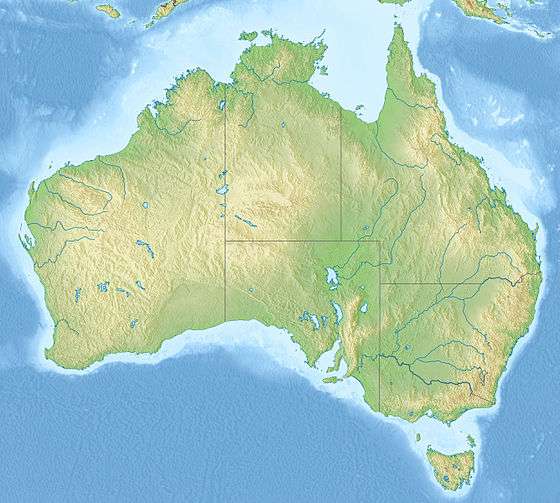Uppsala Southern Schmidt Telescope
The Uppsala Schmidt Telescope was moved to Siding Spring Observatory from Mount Stromlo Observatory in 1982. The instrument has been used to study the galaxy, asteroids and comets. It was last dedicated to the Siding Spring Survey. The telescope had a field of view of just over 6° through the use of a correcting plate, making its field three times as large as that of the Anglo-Australian Telescope. It used a spherical rather than a parabolic mirror[1] with 0.6 m correcting plate to achieve this. Photographic plates and film were used as detectors.
| Part of | Siding Spring Observatory |
|---|---|
| Location(s) | New South Wales, AUS |
| Coordinates | 31°16′24″S 149°03′52″E |
| Organization | Australian National University |
| Altitude | 1,150 m (3,770 ft) |
| Built | 1956 |
| Decommissioned | 2013 |
| Telescope style | optical telescope Schmidt camera |
| Diameter | 0.5 m (1 ft 8 in) |
| Website | www |
 Location of Uppsala Southern Schmidt Telescope | |
History
The Uppsala Schmidt Telescope was built in 1956 in Sweden.[1] The telescope was originally located at the Mount Stromlo Observatory. It was operational there between 1957 and 1982.[2] It took the first images ever recorded of the Sputnik satellite in 1957.[1]
The telescope was modernised in 2000 and 2001[2] to include the experimental use of Charge-coupled devices (CCDs) which are 40 times more sensitive than standard photography. The Uppsala Schmidt telescope was the instrument used by the Siding Spring Survey to conduct the only professional search for dangerous asteroids being made in the Southern Hemisphere.[3] The telescope was decommissioned by the ANU late in 2013 and the Siding Spring Survey near-Earth object search program closed down after funding dried up.[4]
Discoveries
The telescope was used by Robert H. McNaught to discover 400 potentially hazardous near-Earth asteroids which have a diameter greater than 100 metres (330 ft).[5] McNaught used the telescope to discover comet C/2006 P1, also known as the Great Daylight Comet of 2007, on the night of 7 August 2006. That comet was the brightest seen in over 40 years.
Other notable discoveries made by the telescope include finding 7604 Kridsadaporn, C/2007 Q3, C/2009 R1, C/2013 A1 ("Siding Spring Comet"), 2012 LZ1, (242450) 2004 QY2 and (308242) 2005 GO21.
References
- "Uppsala 0.5m Schmidt Near Earth Object Survey Telescope". Australian National University. Archived from the original on 24 April 2013. Retrieved 16 April 2013.
- Mobberley, Martin (2011). Hunting and imaging comets. Springer. pp. 94–95. ISBN 1441969055. Retrieved 16 April 2013.
- Nicky Phillips; Tim Lester (11 July 2012). "Funding black hole means our asteroid sentinel may abandon crucial work". Sydney Morning Herald. Fairfax Media. Retrieved 16 April 2013.
- Safi, Michael (20 October 2014). "Earth at risk after cuts close comet-spotting program, scientists warn". The Guardian. Retrieved 25 November 2015.
- Perry Vlahos (20 December 2012). "Who's on night watch?". Sydney Morning Herald. Fairfax Media. Retrieved 16 April 2013.
External links
- Uppsala Southern Station - history,images,links